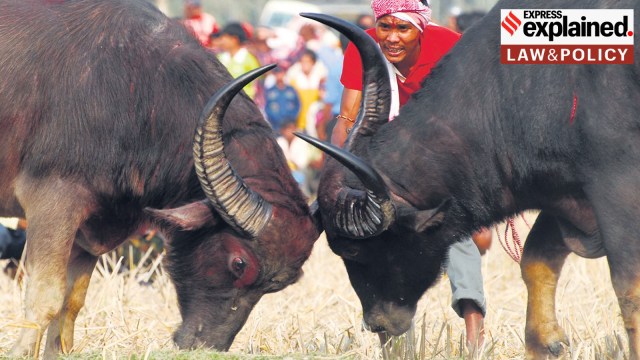The Gauhati High Court earlier this week struck down a notification issued by the Assam government in January attempting to revive the practices of traditional buffalo and bulbul (songbird) fights during Magh Bihu Assam. These practices have been banned for a decade.
In doing so, the court observed that the Assam government had sought to override provisions of the Prevention of Cruelty to Animals Act, 1960, the Wildlife Protection Act, 1972, and the Supreme Court’s 2014 judgement which outlawed the use of bulls as performing animals in jallikattu, kambala and bullock cart races.

What are these traditions? Why and how did the Assam government try to revive them? Why did the Gauhati HC disallow them despite jallikattu, kambala and bullock cart races being permitted again in Tamil Nadu, Karnataka and Maharashtra respectively since 2023?
Long-time traditions
The buffalo and bulbul fights are part of the folk culture associated with the Assamese winter harvest festival of Magh Bihu, which takes place in January.
Buffalo fights are held in different parts of Assam during Magh Bihu, with Ahatguri in Nagaon district being the biggest centre. There, the fights have been conducted for many decades by the Ahatguri Anchalik Moh-jooj aru Bhogali Utsav Udjapan Samiti, drawing huge crowds.
Bulbul fights, on the other hand, are an attraction at the Hayagriv Madhab Mandir in Hajo, around 30 km from Guwahati. Participants rear birds for around two weeks before Bihu, before they are made to fight until one emerges stronger. Temple authorities say this practice has been around for centuries and was conducted by regents of the Ahom dynasty (13th to 19th century).
A nine-year-old ban
The fights were stopped on the heels of the SC’s 2014 judgement, which had also directed the Animal Welfare Board of India (AWBI) to ensure that “the person in charge or care of the animal shall not incite any animal to fight against a human being or another animal.” Subsequently, the AWBI wrote to the Assam government in January 2015, seeking an end to animal and bird fights during Bihu celebrations, following which the government directed district administrations to prevent them. This prohibition continued to be in place despite legal challenges to the order.
Story continues below this ad
However, in May 2023, the SC overruled its 2014 ban by upholding amendments made by Tamil Nadu, Maharashtra, and Karnataka governments to the Prevention of Cruelty to Animals Act 1960 to allow jallikattu, kambala and bullock cart racing.
Subsequently, the Assam government framed and released SOPs this January to conduct these fights, permissible only in places where they have been “traditionally conducted” for the last 25 years, and that moh juj (buffalo fights) will only be allowed between January 15 and January 25. The SOPs aimed to have these fights practised without “deliberate torture or cruelty” to the animals and included a prohibition on human-inflicted injuries, and a ban on the use of intoxicating or performance-enhancing drugs, as well as sharp instruments to instigate the animals for the buffalo fights.
The bulbul fight SOPs require the organisers to ensure that the birds are released in the open “in perfect condition” at the end of the game. The SOPs state that any organisation violating the stipulations will face a ban for the next five years.
Following the release of these SOPs, the 2024 Magh Bihu saw both practices being held again with Assam Chief Minister Himanta Biswa Sarma referring to this as an effort to “preserve Assam’s timeless Bihu traditions.”
Story continues below this ad
The challenge
The Assam government’s notification and the SOPs were challenged by PETA India in the Gauhati HC which sought a prohibition of these activities. In two linked petitions, they claimed that during their investigation of the events in both Ahatguri and Hajo this year, they found that the buffalos had been subjected to pain and injury, and the bulbuls had been illegally captured and “incited, against their natural instincts to fight over food.”
The counsel for the state government submitted that the allegations made in the petitions were already addressed by the SOPs.
The court observed that under the 1972 Wildlife Protection Act, the definition of “hunting” extends to “capturing, coursing, snaring, trapping, driving or baiting any wild or captive animal and every attempt to do so”.
Justice Devashis Baruah stated that since bulbuls are protected under Schedule II of the Act, “irrespective of regulated measures” the practice is contrary to the provisions of the Act.
The court also found the state government’s notification contrary to Section 22 of the 1960 Protection of Animals Act read with a 2011 gazetted notification by the Central government which prohibits exhibiting or training “bulls” as performing animals.
Story continues below this ad
Justice Baruah observed that the SC in 2023 had allowed the bull-taming sports in Tamil Nadu, Karnataka, and Maharashtra as the states had made amendments to the 1960 Act which had received Presidential Assent.
“In the instant case it is noticed that the state of Assam, instead of making amendments to the 1960 Act as had been done by Maharashtra, Tamil Nadu and Karnataka, has resorted to overcome the Protection of Animals Act of 1960 as well as the Wildlife Protection Act of 1972 as well as 2014 Supreme Court Judgement in the case of A Nagaraj by way of an executive instruction which in the opinion of this court is not permissible,” he stated.








































